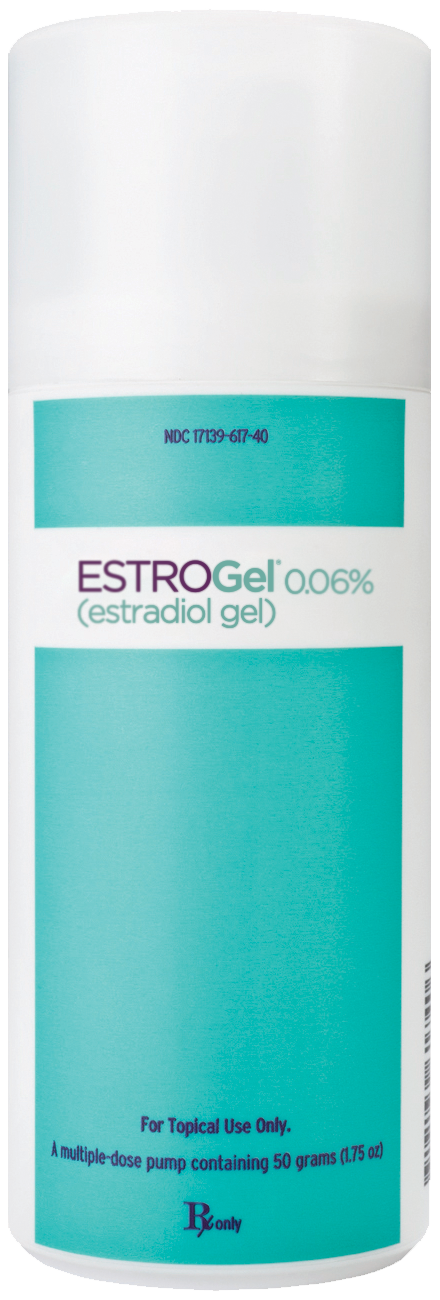Why Choose EstroGel?


One Gel. Two Indications.
EstroGel® 0.06% (estradiol gel) is the first and only non-patch, non-film transdermal estrogen indicated for treatment of both1
 |
Moderate to severe symptoms of vulvar and vaginal atrophy (VVA) due to menopause* |
| * | When prescribing solely for the treatment of moderate to severe symptoms of valvular and vaginal atrophy due to menopause, first consider the use of topical vaginal products.1 |
 |
Moderate to severe vasomotor symptoms (VMS) due to menopause |
Moderate to severe symptoms of VVA due to menopause may include vaginal dryness, vaginal and/or vulvar irritation/itching, dysuria, and vaginal pain associated with sexual activity.2
One Transdermal Application per Day.
EstroGel avoids first-pass liver metabolism, delivering estrogen through the skin into the bloodstream. The clinical significance of avoiding first-pass liver metabolism and the effect of transdermal delivery have not been determined.1
Estrogen-alone therapy may increase the risks of stroke, deep vein thrombosis, endometrial cancer and dementia, and estrogen plus progestin therapy may increase the risks of invasive breast cancer, deep vein thrombosis, pulmonary embolism, stroke, myocardial infarction and dementia.1
One Simple List of Ingredients.
EstroGel contains 5 ingredients.1
One Pump. One Dose.
One pump depression of EstroGel 0.06% delivers 1.25 g of gel containing 0.75 mg estradiol.1
One Arm. No Rotation.
EstroGel is applied to the entire arm on the inside and outside from wrist to shoulder. No application site rotation is required.1
One Invisible Option.
EstroGel is a clear, colorless gel. After application to skin, EstroGel dries in 2 to 5 minutes. Once dried, EstroGel is invisible.
One Low Rate of Application Site Reactions.
In 2 controlled clinical trials, only 0.6% of patients who received EstroGel 1.25 g reported application site reactions.1
Inform postmenopausal women of possible less serious adverse reactions of estrogen-alone therapy such as headache, breast pain and tenderness, nausea, and vomiting.1
One Hour On, No Measurable Transfer.
One hour after gel application in a clinical study, there was no measurable transfer of estradiol to nondosed healthy postmenopausal females (n=24) after direct skin-to-skin contact with subjects administered EstroGel.1
One Consistent Level All Day.
EstroGel has an approximately 36-hour half-life. Serum concentrations appeared to reach steady state after 3 days.1†
| † | Steady state achieved after the third daily application of a 2.5-g dose of EstroGel (1.25 g on each arm); dose not approved in the United States (EstroGel Prescribing Information, Section 12.3).1 |
One Rate-Limiting Factor.
When EstroGel is applied to skin, the rate-limiting factor for transport of estradiol into systemic circulation is the rate of diffusion across the stratum corneum.1
One Option Patients Prefer.
9 out of 10 patients surveyed online (88% of 890 responding) are satisfied to extremely satisfied with EstroGel.3‡
9 out of 10 patients surveyed online (89% of 620 responding) prefer EstroGel over their previous hormone therapy.3‡
| ‡ | Survey sponsored by ASCEND Therapeutics. |
EstroGel is tried and tested

EstroGel is tried and tested
 |
Approved to treat some menopausal symptoms in 70 countries4§ |
 |
Used worldwide for more than 40 years4§ |
 |
Well studied (more than 55 publications)4§ |
| § | Includes dosages, formulations, and indications that are not approved in the United States. EstroGel was approved for use in the US in 2004.4 |
Order samples or patient education materials: contact your local EstroGel representative or call ASCEND Therapeutics at 1-855-786-0738. |
References: 1. EstroGel [package insert]. Herndon, VA: ASCEND Therapeutics; 2020. 2. Food and Drug Administration. Estrogen and estrogen/progestin drug products to treat vasomotor symptoms and vulvar and vaginal atrophy symptoms—recommendations for clinical evaluation. Draft guidance. Washington, DC; US Department of Health and Human Services; January 2003. 3. Simon JA, Mackowiak JI. Independent web-based vs “meaningful use” patient portals in assessing patient-reported outcomes: the estradiol gel 0.06% case study. Sex Reprod Menopause. October 2011;(suppl):1-9. 4. Data on file, ASCEND Therapeutics.
